5G Technology in the Digital Transformation of Healthcare, a Systematic Review
Abstract
:1. Introduction
2. Methodology
2.1. Type of Study
2.2. Research Questions
2.3. Search Strategies
2.4. Inclusion and Exclusion Criteria
3. Results
4. Discussion
4.1. RQ1. Which Countries Have the Most Research, in the last 5 Years, Related to Technological Advances in Healthcare Using 5G Networks?
4.2. RQ2.Which Digital Technologies Are the Most Used to Improve Medical Care and Health Quality?
4.3. RQ3. What Are the 5G-Based Applications Used in Medicine to Improve Medical Care and Healthcare Quality?
4.4. RQ4. Which Database and Programming Languages in Telemedicine Are Most Commonly Used in 5G-Based Applications?
4.5. RQ5. What Is the Functionality Available for Telemedicine Based on the Use of 5G-Based Applications?
4.6. Related Articles
5. Conclusions
Author Contributions
Funding
Institutional Review Board Statement
Informed Consent Statement
Data Availability Statement
Acknowledgments
Conflicts of Interest
References
- World Health Organization. Our Work. Available online: https://www.who.int/our-work (accessed on 1 November 2022).
- U. Nations. Salud|Naciones Unidas. Available online: https://www.un.org/es/global-issues/health (accessed on 23 October 2022).
- Naciones Unidas. Portada—Desarrollo Sostenible. Available online: https://www.un.org/sustainabledevelopment/es/ (accessed on 25 October 2022).
- World Health Organization. World Health Statistics: Monitoring Health for the SDGs. Available online: https://www.who.int/data/gho/data/themes/world-health-statistics (accessed on 23 October 2022).
- Naciones Unidas. Salud—Desarrollo Sostenible: Objetivo 3 Salud y Bienestar. Available online: https://www.un.org/sustainabledevelopment/es/health/ (accessed on 21 October 2022).
- The World Bank. Universal Health Coverage Overview. 2020. Available online: https://www.worldbank.org/en/topic/universalhealthcoverage (accessed on 25 October 2022).
- The World Bank. Health Overview: Development News, Research, Data|World Bank. 2020. Available online: https://www.worldbank.org/en/topic/health/overview#1 (accessed on 25 October 2022).
- United Nations. SDG Indicators. Available online: https://unstats.un.org/sdgs/report/2019/goal-03/ (accessed on 21 October 2022).
- World Health Organization. WHO Hosts Second Global Consultation on Assistive Technology. 2021. Available online: https://www.who.int/news/item/04-11-2021-who-hosts-second-global-consultation-on-assistive-technology (accessed on 24 October 2022).
- Rodríguez-Gemade, A.M.; Gandur-Manzano, A.K. Red 5G: ¿Beneficio o sacrificio? Rev. Convicciones 2020, 7, 23–28. Available online: https://www.fesc.edu.co/Revistas/OJS/index.php/convicciones/article/view/652 (accessed on 23 October 2022).
- Massaro, M.; Kim, S. Why is South Korea at the forefront of 5G? Insights from technology systems theory. Telecomm. Policy 2022, 46, 102290. [Google Scholar] [CrossRef]
- GSMA. Asia Set to Become World’s Largest 5G Region by 2025—Newsroom. 2018. Available online: https://www.gsma.com/newsroom/press-release/gsma-asia-set-to-become-worlds-largest-5g-region-by-2025/ (accessed on 6 November 2022).
- Agiwal, M.; Roy, A.; Saxena, N. Next generation 5G wireless networks: A comprehensive survey. IEEE Commun. Surv. Tutor. 2016, 18, 1617–1655. [Google Scholar] [CrossRef]
- Belmonte, P.; Maestú, C.; Navarro, E. ¿Es Seguro para la Salud el 5G? 2019. Available online: https://www.ecologistasenaccion.org/wp-content/uploads/2019/09/es-seguro-para-la-salud-el-5g.pdf (accessed on 23 October 2022).
- Bushberg, J.T.; Chou, C.K.; Foster, K.R.; Kavet, R.; Maxson, D.P.; Tell, R.A.; Ziskin, M.C. IEEE committee on man and radiation—COMAR technical information statement: Health and safety issues concerning exposure of the general public to electromagnetic energy from 5G wireless communications networks. Health Phys. 2020, 119, 236–246. [Google Scholar] [CrossRef] [PubMed]
- Ziegelberger, G. ICNIRP statement on the ‘guidelines for limiting exposure to time-varying electric, magnetic, and electromagnetic fields (UP to 300 GHz). Health Phys. 2009, 97, 257–258. [Google Scholar] [CrossRef]
- Talty, J.T. Principles of Nonionizing Radiation. In Industrial Hygiene Engineering; Elsevier: Amsterdam, The Netherlands, 1998; pp. 564–597. [Google Scholar] [CrossRef]
- Sofri, T.; Rahim, H.A.; Abdulmalek, M.; Abd Rani, K.; Omar, M.H.; Yasin, M.N.M.; Jusoh, M.; Soh, P.J. Health Effects of 5G Base Station Exposure: A Systematic Review. IEEE Access 2022, 10, 41639–41656. [Google Scholar] [CrossRef]
- Schandy, A.; Simini, F. Mobile phone radiation and brain cancer at the dawn of the 5G era. Rev. Argent. Bioingeniería 2020, 24, 2020. [Google Scholar]
- The European Union. About—5G Appeal. Available online: http://www.5gappeal.eu/about/ (accessed on 7 November 2022).
- The European Union. The Appeal—5G Appeal. Available online: http://www.5gappeal.eu/scientists-and-doctors-warn-of-potential-serious-health-effects-of-5g/ (accessed on 7 November 2022).
- Angelucci, A.; Kuller, D.; Aliverti, A. A home telemedicine system for continuous respiratory monitoring. IEEE J Biomed Health Inform. 2021, 25, 1247–1256. [Google Scholar] [CrossRef]
- Perez, S. App Stores Saw Record 204 Billion App Downloads in 2019, Consumer Spend of $120 Billion|TechCrunch. 2020. Available online: https://techcrunch.com/2020/01/15/app-stores-saw-record-204-billion-app-downloads-in-2019-consumer-spend-of-120-billion/ (accessed on 6 November 2022).
- GSMA. The Mobile Economy. 2022. Available online: https://www.gsma.com/mobileeconomy/#backToTopButton (accessed on 6 November 2022).
- GSMA. The Mobile Economy 2022. 2022. Available online: www.gsmaintelligence.com (accessed on 7 November 2022).
- Zhang, Z.; Wen, F.; Sun, Z.; Guo, X.; He, T.; Lee, C. Artificial Intelligence-Enabled Sensing Technologies in the 5G/Internet of Things Era: From Virtual Reality/Augmented Reality to the Digital Twin. Advanced Intelligent Syst. 2022, 4, 2100228. [Google Scholar] [CrossRef]
- Torres Vega, M.; Liaskos, C.; Abadal, S.; Papapetrou, E.; Jain, A.; Mouhouche, B.; Kalem, G.; Ergüt, S.; Mach, M.; Sabol, T.; et al. Immersive Interconnected Virtual and Augmented Reality: A 5G and IoT Perspective. J. Netw. Syst. Manag. 2020, 28, 796–826. [Google Scholar] [CrossRef]
- Yu, K.; Tan, L.; Lin, L.; Cheng, X.; Yi, Z.; Sato, T. Deep-Learning-Empowered Breast Cancer Auxiliary Diagnosis for 5GB Remote E-Health. IEEE Wirel Commun. 2021, 28, 54–61. [Google Scholar] [CrossRef]
- Meshram, D.A.; Patil, D.D. 5G Enabled Tactile Internet for Tele-Robotic Surgery. Procedia Comput Sci. 2020, 171, 2618–2625. [Google Scholar] [CrossRef]
- Lacy, A.M.; Bravo, R.; Otero-Piñeiro, A.M.; Pena, R.; De Lacy, F.B.; Menchaca, R.; Balibrea, J.M. 5G-assisted telementored surgery. Br. J. Surg. 2019, 106, 1576–1579. [Google Scholar] [CrossRef]
- Okoli, C. A Guide to Conducting a Standalone Systematic Literature Review. Commun. Assoc. Inf. Syst. 2015, 37, 43. [Google Scholar] [CrossRef]
- Parums, D.V. Review Articles, Systematic Reviews, Meta-Analysis, and the Updated Preferred Reporting Items for Systematic Reviews and Meta-Analyses (PRISMA) 2020 Guidelines. Med. Sci. Monit. 2021, 27, e934475-1. [Google Scholar] [CrossRef]
- Ahmad, P.; Asif, J.A.; Alam, M.K.; Slots, J. A bibliometric analysis of Periodontology 2000. Periodontol 2000 2020, 82, 286–297. [Google Scholar] [CrossRef]
- Dixit, A.S.; Shevada, L.K.; Raut, H.D.; Malekar, R.R.; Kumar, S. Fifth Generation Antennas: A Bibliometric Survey and Future Research Directions. Libr. Philos. Pract. 2020, 2020, 4575. [Google Scholar]
- Van Eck, N.J.; Waltman, L. Software survey: VOSviewer, a computer program for bibliometric mapping. Scientometrics 2010, 84, 523. [Google Scholar] [CrossRef]
- Unite Nations. World Population Prospects 2019 Data Booklet. 2011. Available online: https://www.un.org/development/desa/pd/content/world-population-prospects-2019-data-booklet (accessed on 19 January 2023).
- Alrubaee, S.H.; Burhan, B.B. Study of 5G Networks as a Promising Future Wireless Mobile. In Proceedings of the International Conference on Communication and Information Technology, ICICT 2021, Basrah, Iraq, 5–6 June 2021; pp. 127–132. [Google Scholar] [CrossRef]
- Gharba, M.; Xiao, X.; Cao, H.; Eichinger, J.; Hecker, A.; Kranzfelder, M.; Ostler, D. A Field Test of 5G Enhanced Mobile Ultrasound with Network Slicing. In Proceedings of the 2021 IEEE Globecom Workshops (GC Wkshps), Madrid, Spain, 7–11 December 2021; pp. 1–6. [Google Scholar] [CrossRef]
- Jain, H.; Chamola, V.; Jain, Y.; Naren. 5G network slice for digital real-time healthcare system powered by network data analytics. Internet Things Cyber-Phys. Syst. 2021, 1, 14–21. [Google Scholar] [CrossRef]
- Haleem, A.; Javaid, M. Pratap Singh, and R. Suman. Medical 4.0 technologies for healthcare: Features, capabilities, and applications. Internet Things Cyber-Phys. Syst. 2022, 2, 12–30. [Google Scholar] [CrossRef]
- Satheeshkumar, R.; Saini, K.; Daniel, A.; Khari, M. 5G—Communication in HealthCare applications. In Advances in Computers; Academic Press Inc.: Cambridge, MA, USA, 2022; pp. 485–506. [Google Scholar] [CrossRef]
- Deivakani, M.; Neeraja, B.; Reddy, K.S.; Sharma, H.; Aparna, G. Core Technologies and Harmful Effects of 5G Wireless Technology. J. Phys. Conf. Ser. 2021, 1817, 012006. [Google Scholar] [CrossRef]
- Inupakutika, D.; Rodriguez, G.; Akopian, D.; Lama, P.; Chalela, P.; Ramirez, A.G. On the Performance of Cloud-Based mHealth Applications: A Methodology on Measuring Service Response Time and a Case Study. IEEE Access. 2022, 10. Available online: https://ieeexplore.ieee.org/document/9774331/ (accessed on 13 November 2022). [CrossRef]
- Archana, R.; Vaishnavi, C.; Priyanka, D.S.; Gunaki, S.; Swamy, S.R.; Honnavalli, P.B. Remote Health Monitoring using IoT and Edge Computing. In Proceedings of the 2022 International Conference on IoT and Blockchain Technology (ICIBT), Ranchi, India, 6–8 May 2022; Available online: https://ieeexplore.ieee.org/document/9807710/ (accessed on 13 November 2022).
- Dang, X.-T.; Knauer, R.; Peters, S.; Sivrikaya, F. A Converged Cloud-Fog Architecture for Future eHealth Applications. In Proceedings of the 2021 Sixth International Conference on Fog and Mobile Edge Computing (FMEC), Gandia, Spain, 6–9 December 2021; Available online: https://ieeexplore.ieee.org/document/9732552/ (accessed on 13 November 2022).
- Cisotto, G.; Casarin, E.; Tomasin, S. Requirements and Enablers of Advanced Healthcare Services over Future Cellular Systems. IEEE Commun. Mag. 2020, 58, 76–81. Available online: https://ieeexplore.ieee.org/document/9040267/ (accessed on 13 November 2022). [CrossRef]
- Jiménez, A.C.; Martínez, J.P. 5G networks in eHealth services in Spain: Remote patient monitoring system. In Proceedings of the 2020 IEEE Engineering International Research Conference (EIRCON), Lima, Peru, 21–23 October 2020; Available online: https://ieeexplore.ieee.org/document/9254013/ (accessed on 13 November 2022).
- Martin, N.; Ragot, M.; Savaux, V. Acceptability and 5G in the Medical Field: The Impact of the Level of Information. In Proceedings of the 2021 Zooming Innovation in Consumer Technologies Conference (ZINC), Novi Sad, Serbia, 26–27 May 2021; Available online: https://ieeexplore.ieee.org/document/9499276/ (accessed on 13 November 2022).
- Nasim, I.; Kim, S. Mitigation of Human EMF Exposure in a Cellular Wireless System. In Proceedings of the 2020 IEEE 92nd Vehicular Technology Conference (VTC2020-Fall), Virtual, 18 November–16 December 2020; Available online: https://ieeexplore.ieee.org/document/9348446/ (accessed on 13 November 2022).
- Zhang, D.; Rodrigues, J.J.P.C.; Zhai, Y.; Sato, T. Design and Implementation of 5G e-Health Systems: Technologies, Use Cases, and Future Challenges. IEEE Commun. Mag. 2021, 59, 80–85. [Google Scholar] [CrossRef]
- Ahmed, S.; Shrestha, A.; Yong, J. Towards a User-Level Self-management of COVID-19 Using Mobile Devices Supported by Artificial Intelligence, 5G and the Cloud. Lect. Notes Comput. Sci. 2021, 3079, 33–43. [Google Scholar] [CrossRef]
- Elmousalami, H.H.; Darwish, A.; Hassanien, A.E. The truth about 5G and COVID-19: Basics, analysis, and opportunities. Stud. Syst. Decis. Control 2021, 322, 249–259. [Google Scholar] [CrossRef]
- Liu, X.; Li, N.; Liu, Y.; He, Y. Smart Medical and Nursing Platform Based on 5G Technology. In Lecture Notes of the Institute for Computer Sciences, Social-Informatics and Telecommunications Engineering, LNICST; 413 LNICST; Springer Science and Business Media Deutschland GmbH: Berlin, Germany, 2022; pp. 285–295. [Google Scholar] [CrossRef]
- Lin, K.; Li, Y.; Sun, J.; Zhou, D.; Zhang, Q. Multi-sensor fusion for body sensor network in medical human–robot interaction scenario. Inf. Fusion 2020, 57, 15–26. [Google Scholar] [CrossRef]
- Moreira, M.W.L.; Rodrigues, J.J.P.C.; Kumar, N.; Saleem, K.; Illin, I.V. Postpartum depression prediction through pregnancy data analysis for emotion-aware smart systems. Inf. Fusion 2019, 47, 23–31. [Google Scholar] [CrossRef]
- Khan, S.U.; Islam, N.; Jan, Z.; Din, I.U.; Khan, A.; Faheem, Y. An e-Health care services framework for the detection and classification of breast cancer in breast cytology images as an IoMT application. Future Gener. Comput. Syst. 2019, 98, 286–296. [Google Scholar] [CrossRef]
- Slimen, Y.B.; Balcerzak, J.; Pagès, A.; Agraz, F.; Spadaro, S.; Koutsopoulos, K.; Al-Bado, M.; Truong, T.; Giardina, P.G.; Bernini, G. Quality of perception prediction in 5G slices for e-Health services using user-perceived QoS. Comput. Commun. 2021, 178, 1–13. [Google Scholar] [CrossRef]
- Parmar, R.; Patel, D.; Panchal, N.; Chauhan, U.; Bhatia, J. 5G-enabled deep learning-based framework for healthcare mining: State of the art and challenges. In Blockchain Applications for Healthcare Informatics; Elsevier: Amsterdam, The Netherlands, 2022; pp. 401–420. [Google Scholar] [CrossRef]
- Belyaev, I. Main Regularities and Health Risks from Exposure to Non-Thermal Microwaves of Mobile Communication. In Proceedings of the 2019 14th International Conference on Advanced Technologies, Systems and Services in Telecommunications (TELSIKS), Nis, Serbia, 23–25 October 2019; Available online: https://ieeexplore.ieee.org/document/9002324/ (accessed on 13 November 2022).
- Nasim, I.; Kim, S. Adverse Impacts of 5G Downlinks on Human Body. In 2019 SoutheastCon. 2019. Available online: https://ieeexplore.ieee.org/document/9020454/ (accessed on 13 November 2022).
- Moglia, A.; Georgiou, K.; Marinov, B.; Georgiou, E.; Berchiolli, R.N.; Satava, R.M.; Cuschieri, A. 5G in Healthcare: From COVID-19 to Future Challenges. IEEE J Biomed Health Inform. 2022, 26, 8. Available online: https://ieeexplore.ieee.org/document/9792172/ (accessed on 13 November 2022). [CrossRef]
- Liu, E.; Effiok, E.; Hitchcock, J. Survey on health care applications in 5G networks. IET Commun. 2020, 14, 1073–1080. [Google Scholar] [CrossRef]
- Anu Shilvya, J.; George, S.T.; Subathra, M.S.P.; Manimegalai, P.; Mohammed, M.A.; Jaber, M.M.; Kazemzadeh, A.; Al-Andoli, M.N. Home Based Monitoring for Smart Health-Care Systems: A Survey. Wirel Commun. Mob. Comput. 2022, 2022, 1829876. [Google Scholar] [CrossRef]
- Rahman, M.M.; Khatun, F.; Sami, S.I.; Uzzaman, A. The evolving roles and impacts of 5G enabled technologies in healthcare: The world epidemic COVID-19 issues. Array 2022, 14, 100178. [Google Scholar] [CrossRef]
- Jain, P.; Chawla, P. A Novel Smart Healthcare System Design for Internet of Health Things. In Proceedings of the 2021 International Conference on Innovative Computing, Intelligent Communication and Smart Electrical Systems (ICSES), Chennai, India, 24–25 September 2021; pp. 1–8. [Google Scholar] [CrossRef]
- Tiwari, S.; Sharma, N. Idea, Architecture, and Applications of 5G Enabled IoMT Systems for Smart Health Care System. ECS Trans. 2022, 107, 5499–5508. [Google Scholar] [CrossRef]
- Zakaria, H.; Bakar, N.A.A.; Hassan, N.H.; Yaacob, S. IoT Security Risk Management Model for Secured Practice in Healthcare Environment. Procedia Comput Sci. 2019, 161, 1241–1248. [Google Scholar] [CrossRef]
- Aghdam, Z.N.; Rahmani, A.M.; Hosseinzadeh, M. The Role of the Internet of Things in Healthcare: Future Trends and Challenges. Comput Methods Programs Biomed. 2021, 199, 105903. [Google Scholar] [CrossRef]
- Siriwardhana, Y.; Gür, G.; Ylianttila, M.; Liyanage, M. The role of 5G for digital healthcare against COVID-19 pandemic: Opportunities and challenges. ICT Express 2021, 7, 244–252. [Google Scholar] [CrossRef]
- Abubakari, M.S.; Mashoedah. The Internet of Things (IoT) as an Emerging Technological Solution for the Covid-19 Pandemic Mitigation: An Overview. J. Phys. Conf. Ser. 2021, 1737, 012003. [Google Scholar] [CrossRef]
- Siddiquee, J.A. Access Technologies for Medical IOT Systems. In 2019 ITU Kaleidoscope: ICT for Health: Networks, Standards and Innovation (ITUK). 2019. Available online: https://ieeexplore.ieee.org/document/8996130/ (accessed on 13 November 2022).
- Berlet, M.; Vogel, T.; Gharba, M.; Eichinger, J.; Schulz, E.; Friess, H.; Wilhelm, D.; Ostler, D.; Kranzfelder, M. Emergency Telemedicine Mobile Ultrasounds Using a 5G-Enabled Application: Development and Usability Study. JMIR Form Res. 2022, 6, e36824. [Google Scholar] [CrossRef] [PubMed]
- Jain, G.; Jain, A. Blockchain for 5G-enabled networks in healthcare service based on several aspects. In Blockchain Applications for Healthcare Informatics; Elsevier: Amsterdam, The Netherlands, 2022; pp. 471–493. [Google Scholar] [CrossRef]
- Sharma, A.; Singh, M.; Gupta, M.; Sukhija, N.; Aggarwal, P.K. IoT and blockchain technology in 5G smart healthcare. In Blockchain Applications for Healthcare Informatics; Elsevier: Amsterdam, The Netherlands, 2022; pp. 137–161. [Google Scholar] [CrossRef]
- Ray, P.P.; Dash, D. Blockchain for IoT-based medical delivery drones. In Blockchain Technology for Emerging Applications; Elsevier: Amsterdam, The Netherlands, 2022; pp. 137–176. [Google Scholar] [CrossRef]
- Raghavendra, K.; Kakkar, D. Reliability of 5G in human health monitoring using blockchain technology. In Blockchain Applications for Healthcare Informatics; Elsevier: Amsterdam, The Netherlands, 2022; pp. 313–326. [Google Scholar] [CrossRef]
- Awad, A.I.; Fouda, M.M.; Khashaba, M.M.; Mohamed, E.R.; Hosny, K.M. Utilization of mobile edge computing on the Internet of Medical Things: A survey. ICT Express, 2022; in press. [Google Scholar] [CrossRef]
- Kumaresan, M.; Gopal, R.; Mathivanan, M.; Poongodi, T. Amalgamation of blockchain, IoT, and 5G to improve security and privacy of smart healthcare systems. In Blockchain Applications for Healthcare Informatics; Elsevier: Amsterdam, The Netherlands, 2022; pp. 283–312. [Google Scholar] [CrossRef]
- Sandeep, B.L.; Rao, V.B.; Aditya, K.; Sekhar, S.R.M.; Siddesh, G.M. Blockchain-based privacy approaches for 5G healthcare informatics. In Blockchain Applications for Healthcare Informatics; Elsevier: Amsterdam, The Netherlands, 2022; pp. 213–242. [Google Scholar] [CrossRef]
- Soner, S.; Litoriya, R.; Pandey, P. Combining blockchain and machine learning in healthcare and health informatics: An exploratory study. In Blockchain Applications for Healthcare Informatics; Elsevier: Amsterdam, The Netherlands, 2022; pp. 117–135. [Google Scholar] [CrossRef]
- Bisht, S.; Bisht, N.; Singh, P.; Dasila, S.; Nisar, K.S. Smart healthcare using blockchain technologies: The importance, applications, and challenges. Blockchain Appl. Healthc. Inform. Beyond 5G 2022, 2022, 163–180. [Google Scholar] [CrossRef]
- Wadhwa, S.; Babbar, H.; Rani, S. A Survey on Emerging Software-Defined Networking and Blockchain in Smart Health Care. IOP Conf Ser Mater Sci Eng. 2021, 1022, 012056. [Google Scholar] [CrossRef]
- Chandan, R.K.; Suman, P.N.; Sinha, K. The Environmental Impact of 5G Technology on Humans and Animals. Handbook of Research on Knowledge and Organization Systems in Library and Information Science; IGI Global: Pennsylvania, PA, USA, 2021; pp. 48–68. [Google Scholar] [CrossRef]
- Russell, C.L. 5 G wireless telecommunications expansion: Public health and environmental implications. Environ. Res. 2018, 165, 484–495. [Google Scholar] [CrossRef]
- Franci, D.; Coltellacci, S.; Grillo, E.; Pavoncello, S.; Aureli, T.; Cintoli, R.; Migliore, M.D. Experimental Procedure for Fifth Generation (5G) Electromagnetic Field (EMF) Measurement and Maximum Power Extrapolation for Human Exposure Assessment. Environments 2020, 7, 22. [Google Scholar] [CrossRef]
- Moutaouakil, A.; Jabrane, Y.; Reha, A.; Koumina, A. The Spread of the Corona Virus Disease (Covid-19) and the Launch of 5G Technology in China: What Relationship. Lect. Notes Netw. Syst. 2021, 211, 919–924. [Google Scholar] [CrossRef]
- Lv, Z.; Qiao, L. Analysis of healthcare big data. Future Gener. Comput. Syst. 2020, 109, 103–110. [Google Scholar] [CrossRef]
- Aceto, G.; Persico, V.; Pescapé, A. Industry 4.0 and Health: Internet of Things, Big Data, and Cloud Computing for Healthcare 4.0. J. Ind. Inf. Integr. 2020, 18, 100129. [Google Scholar] [CrossRef]
- Chiaraviglio, L.; Elzanaty, A.; Alouini, M.-S. Health Risks Associated With 5G Exposure: A View from the Communications Engineering Perspective. IEEE Open J. Commun. Soc. 2021, 2, 2131–2179. Available online: https://ieeexplore.ieee.org/document/9518367/ (accessed on 13 November 2022). [CrossRef]
- Ding, L.; Wang, Q.; Zheng, Y.; Chen, X.; Zheng, Y.; Zhang, J.; Xu, H. Analysis of Health Assessment of Water Resources of Futuan River in Rizhao City by 5G Wireless Communication. Wirel Commun Mob Comput. 2022, 2022, 3175769. [Google Scholar] [CrossRef]
- Thuemmler, C.; Paulin, A.; Jell, T.; Lim, A.K. Information Technology—Next Generation: The Impact of 5G on the Evolution of Health and Care Services. In Advances in Intelligent Systems and Computing; Springer Verlag: Berlin, Germany, 2018; pp. 811–817. [Google Scholar] [CrossRef]
- Kamil, I.A.; Ogundoyin, S.O. A lightweight mutual authentication and key agreement protocol for remote surgery application in Tactile Internet environment. Comput. Commun. 2021, 170, 1–18. [Google Scholar] [CrossRef]
- Castellanos, G.; De Gheselle, S.; Martens, L.; Kuster, N.; Joseph, W.; Deruyck, M.; Kuehn, S. Multi-objective optimisation of human exposure for various 5G network topologies in Switzerland. Comput. Netw. 2022, 216, 109255. [Google Scholar] [CrossRef]
- Kim, S.; Nasim, I. Human Electromagnetic Field Exposure in 5G at 28 GHz. IEEE Consum. Electron. Mag. 2020, 9, 41–48. Available online: https://ieeexplore.ieee.org/document/9090831/ (accessed on 13 November 2022). [CrossRef]
- Li, S.; Sun, N. Analysis and Research on5G Medical and Health Technology User Adoption Behavior and Influencing Factors. In Proceedings of the 2020 2nd International Conference on Economic Management and Model Engineering (ICEMME), Chongqing, China, 18–20 November 2020; Available online: https://ieeexplore.ieee.org/document/9434665/ (accessed on 13 November 2022).
- Xu, F. Balance of Public Medical and Health Services and Reform of Medical Institutions Based on 5G Sensor Technology. Wirel Commun Mob Comput. 2022, 2022, 4217888. [Google Scholar] [CrossRef]
- Kim, J.; Campbell, A.S.; de Ávila, B.E.F.; Wang, J. Wearable biosensors for healthcare monitoring. Nat Biotechnol. 2019, 37, 389–406. [Google Scholar] [CrossRef]
- Antunes, R.S.; da Costa, C.A.; Küderle, A.; Yari, I.A.; Eskofier, B. Federated Learning for Healthcare: Systematic Review and Architecture Proposal. ACM Trans. Intell. Syst. Technol. 2022, 13, 54. [Google Scholar] [CrossRef]
- Alenoghena, C.O.; Onumanyi, A.J.; Ohize, H.O.; Adejo, A.O.; Oligbi, M.; Ali, S.I.; Okoh, S.A. eHealth: A Survey of Architectures, Developments in mHealth, Security Concerns and Solutions. Int. J. Environ. Res. Public Health 2022, 19, 13071. [Google Scholar] [CrossRef]
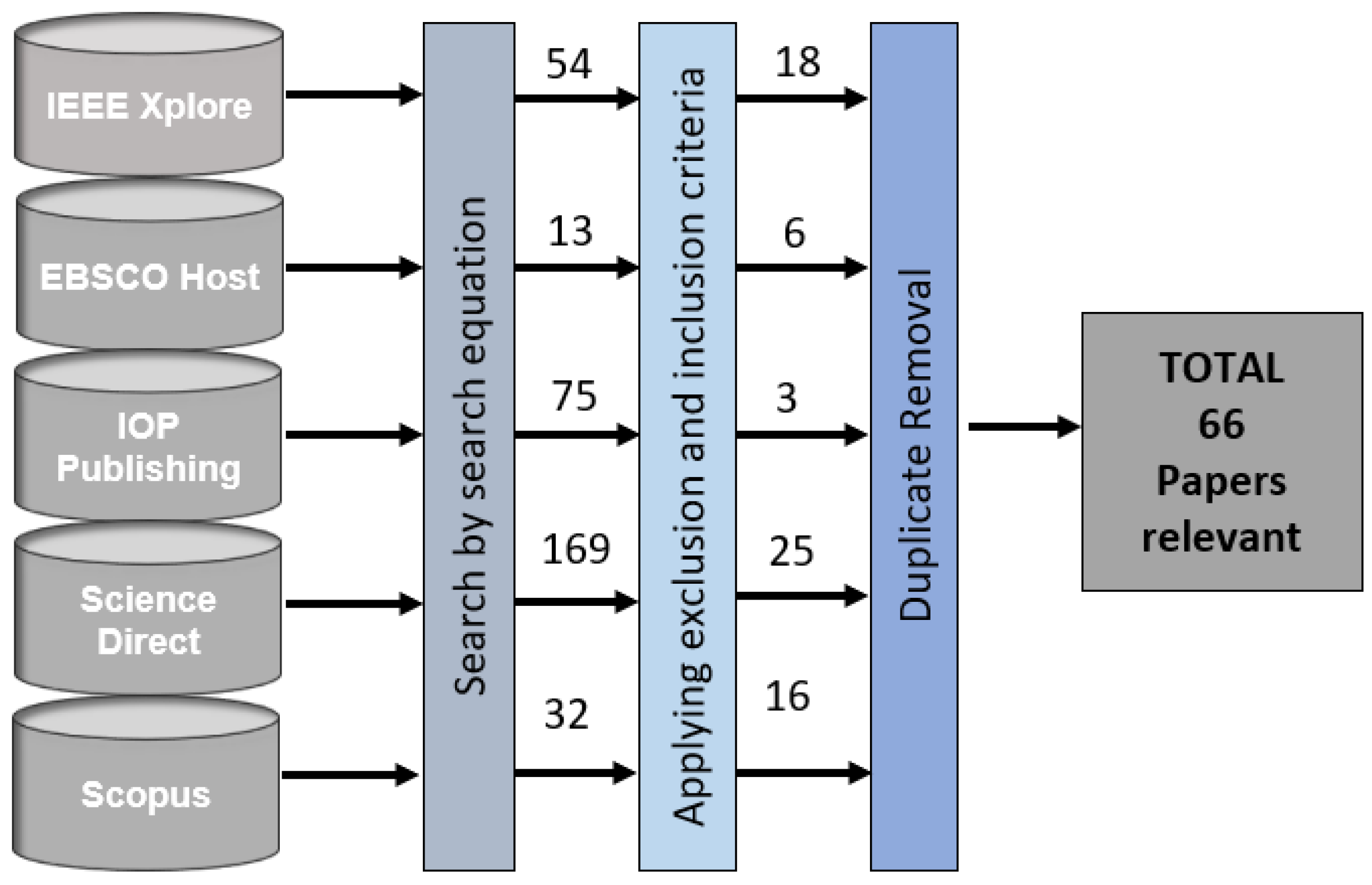
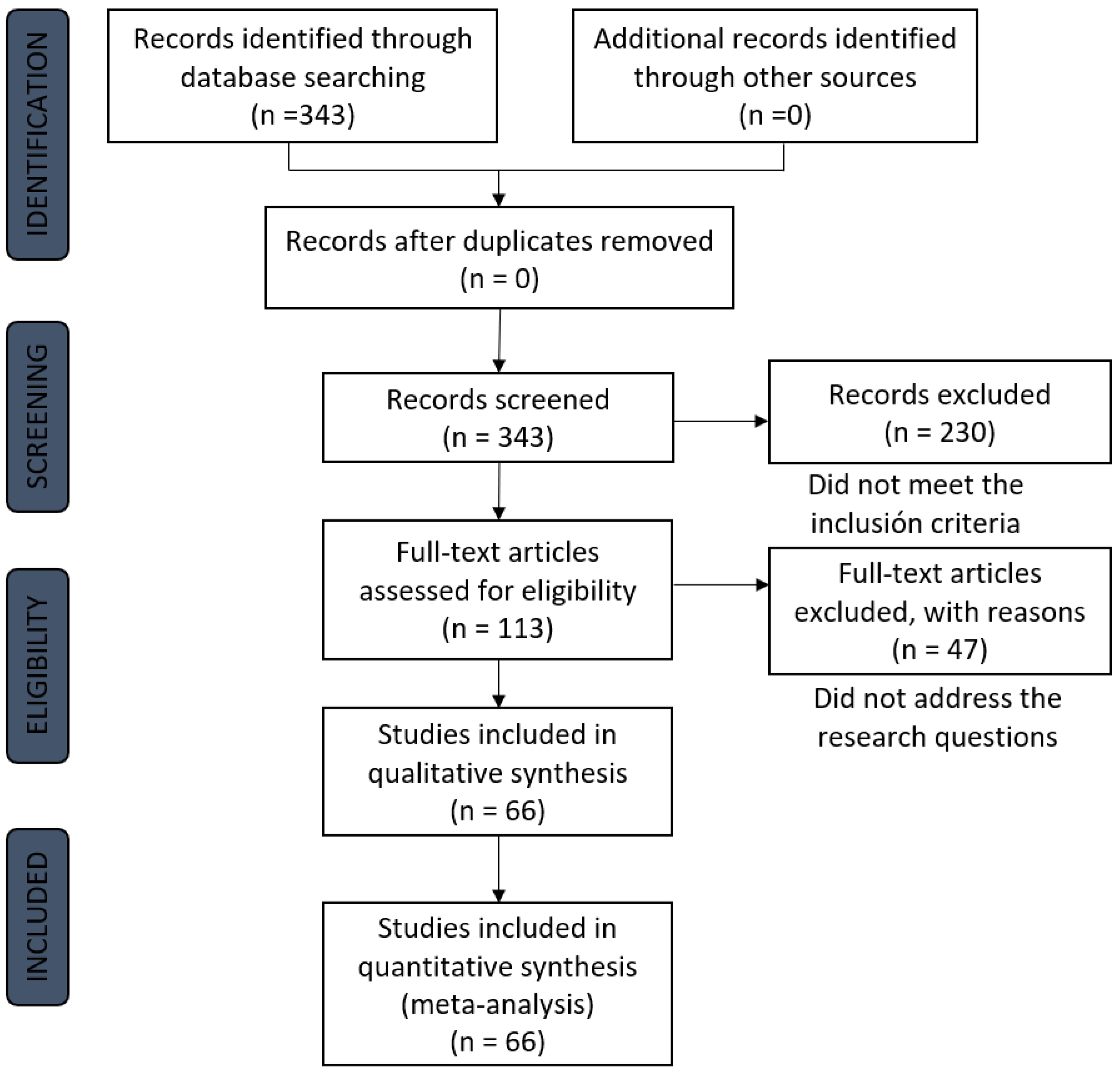
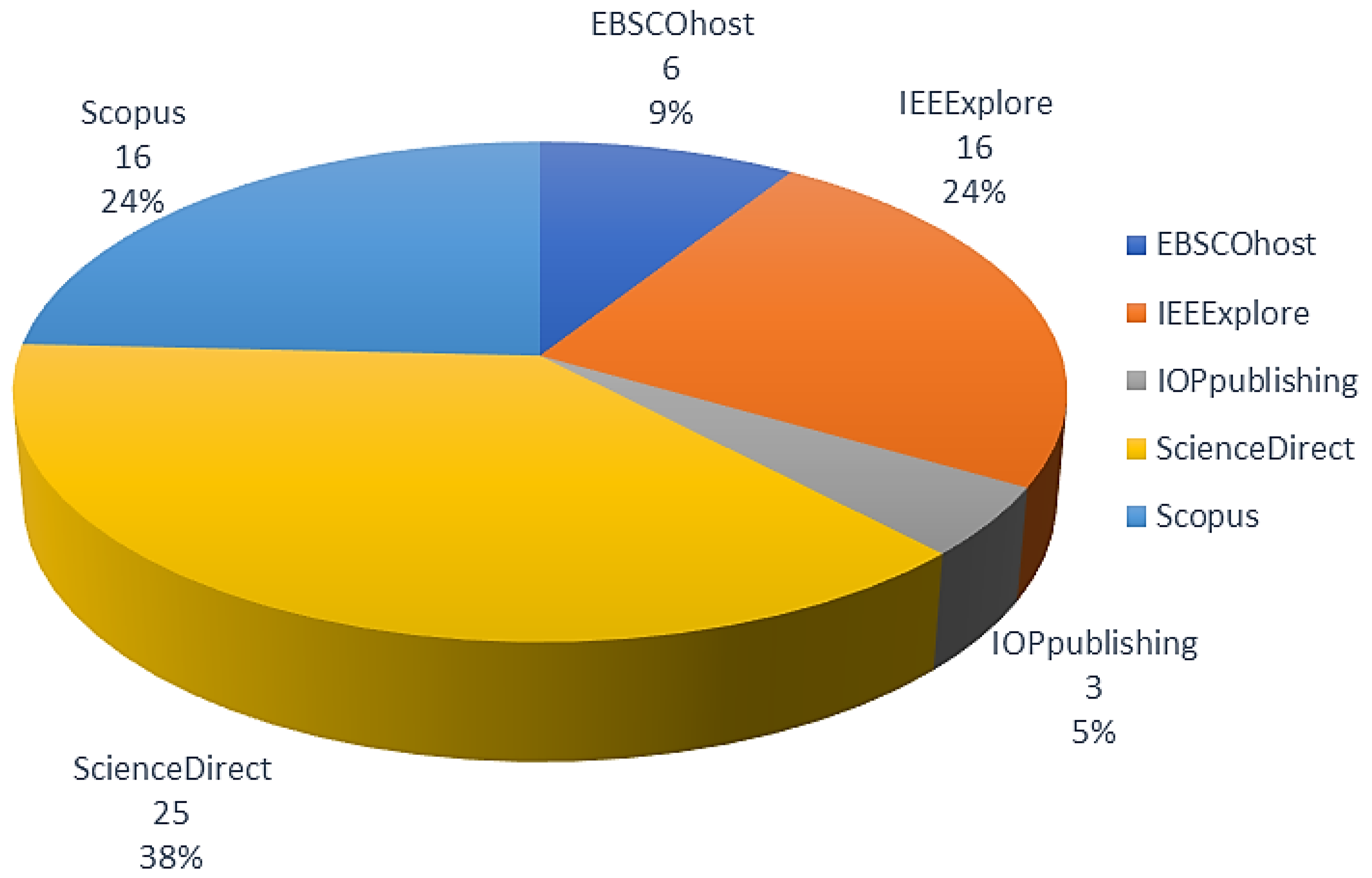
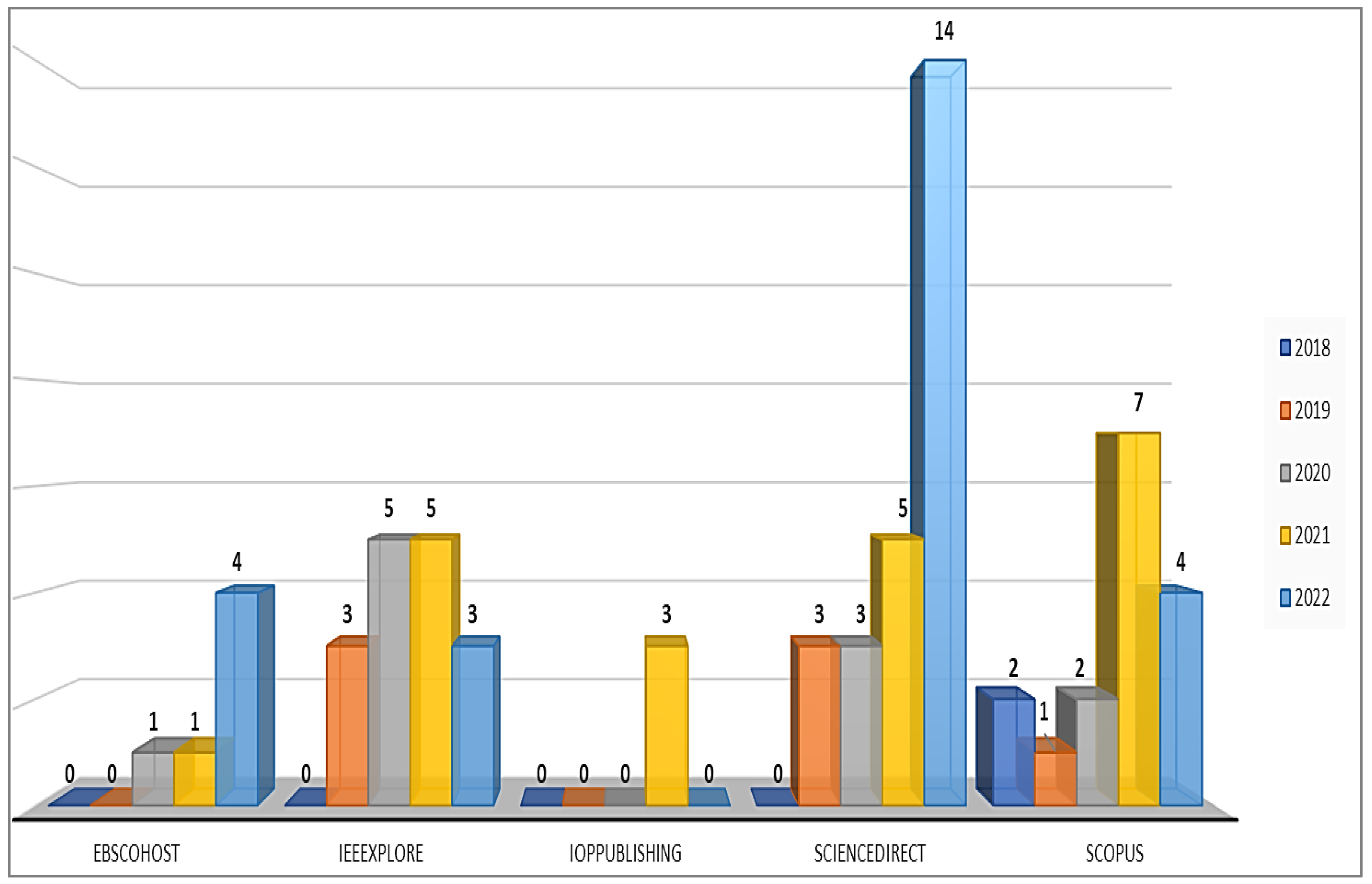

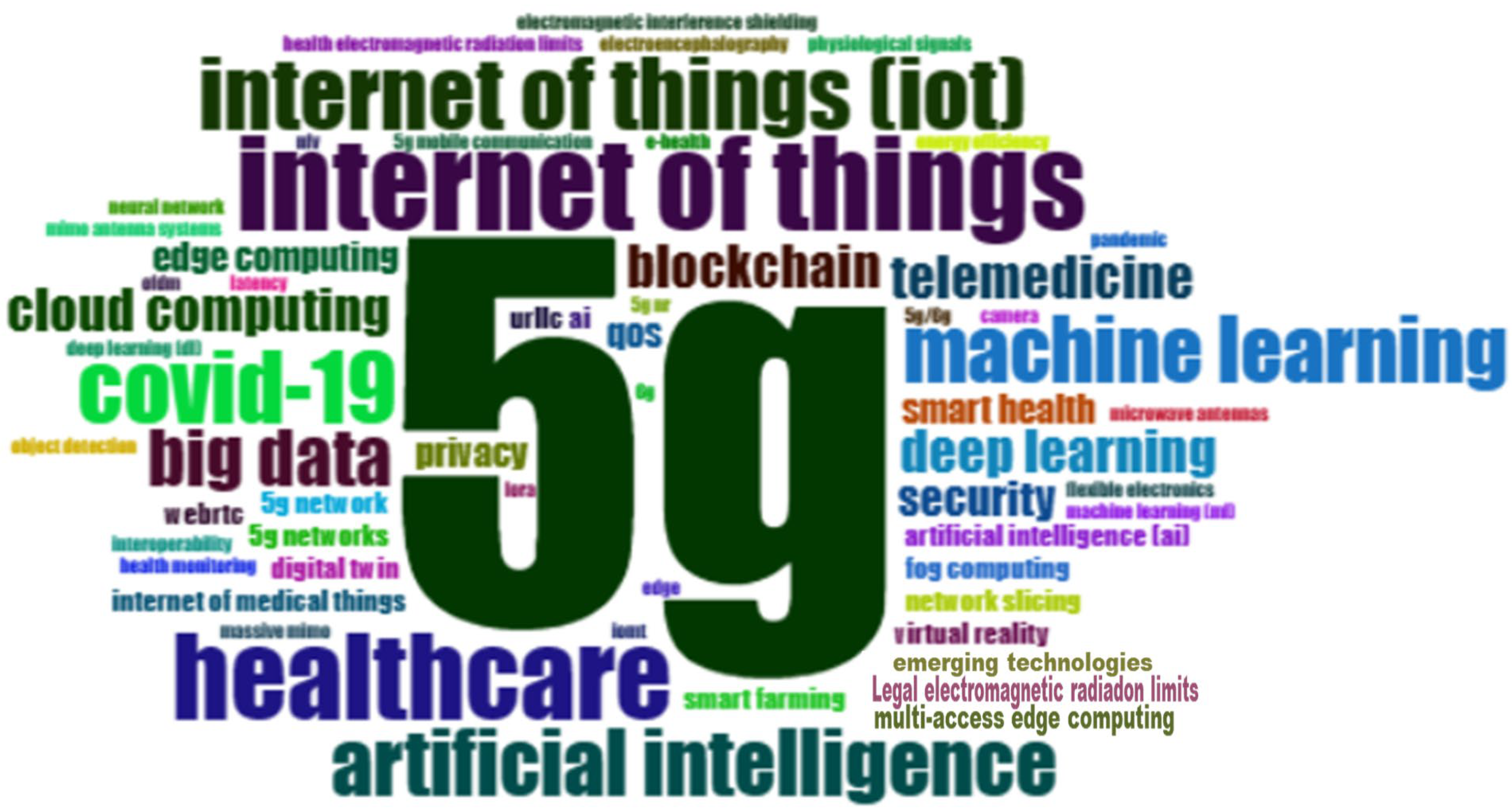
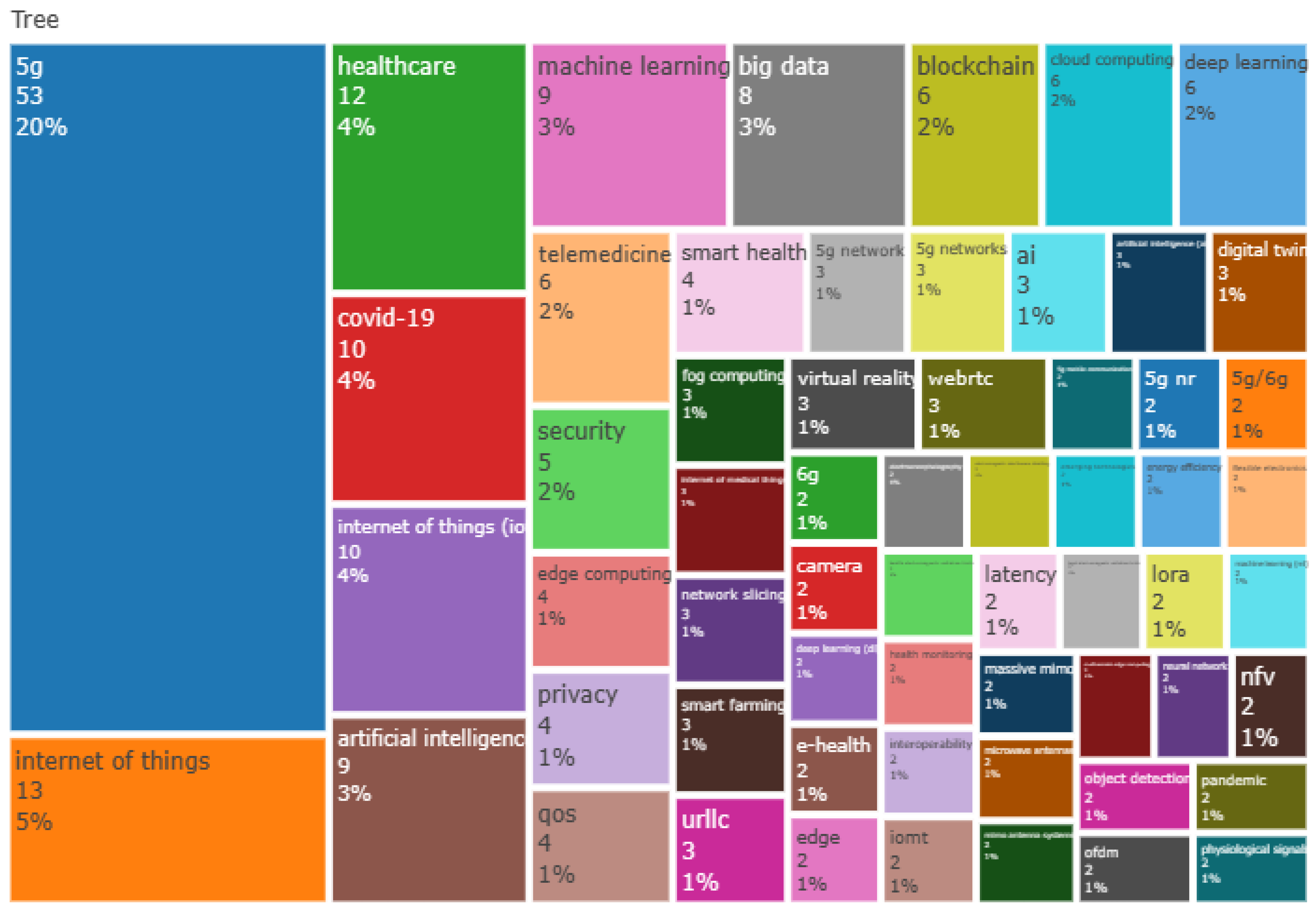
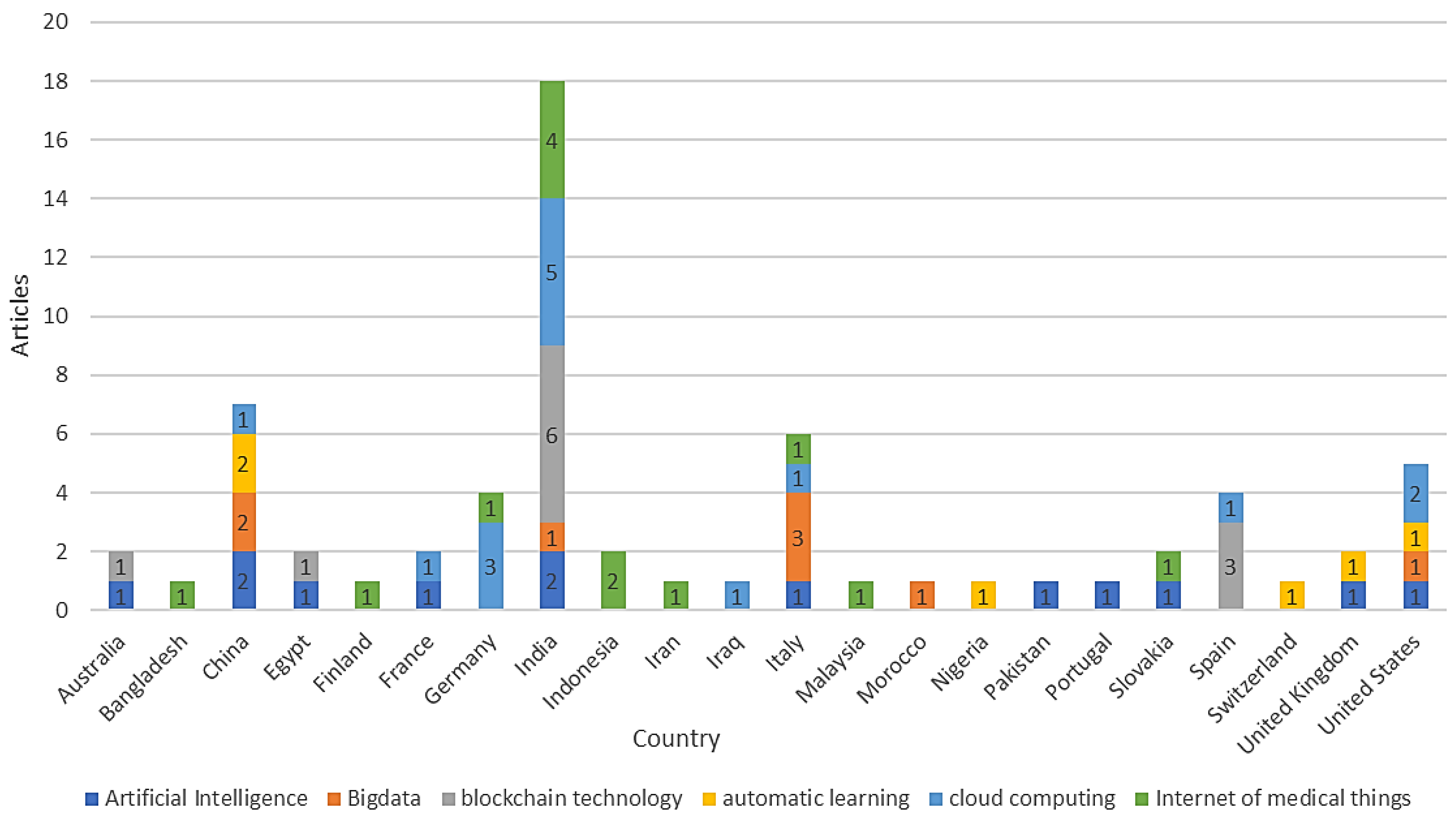
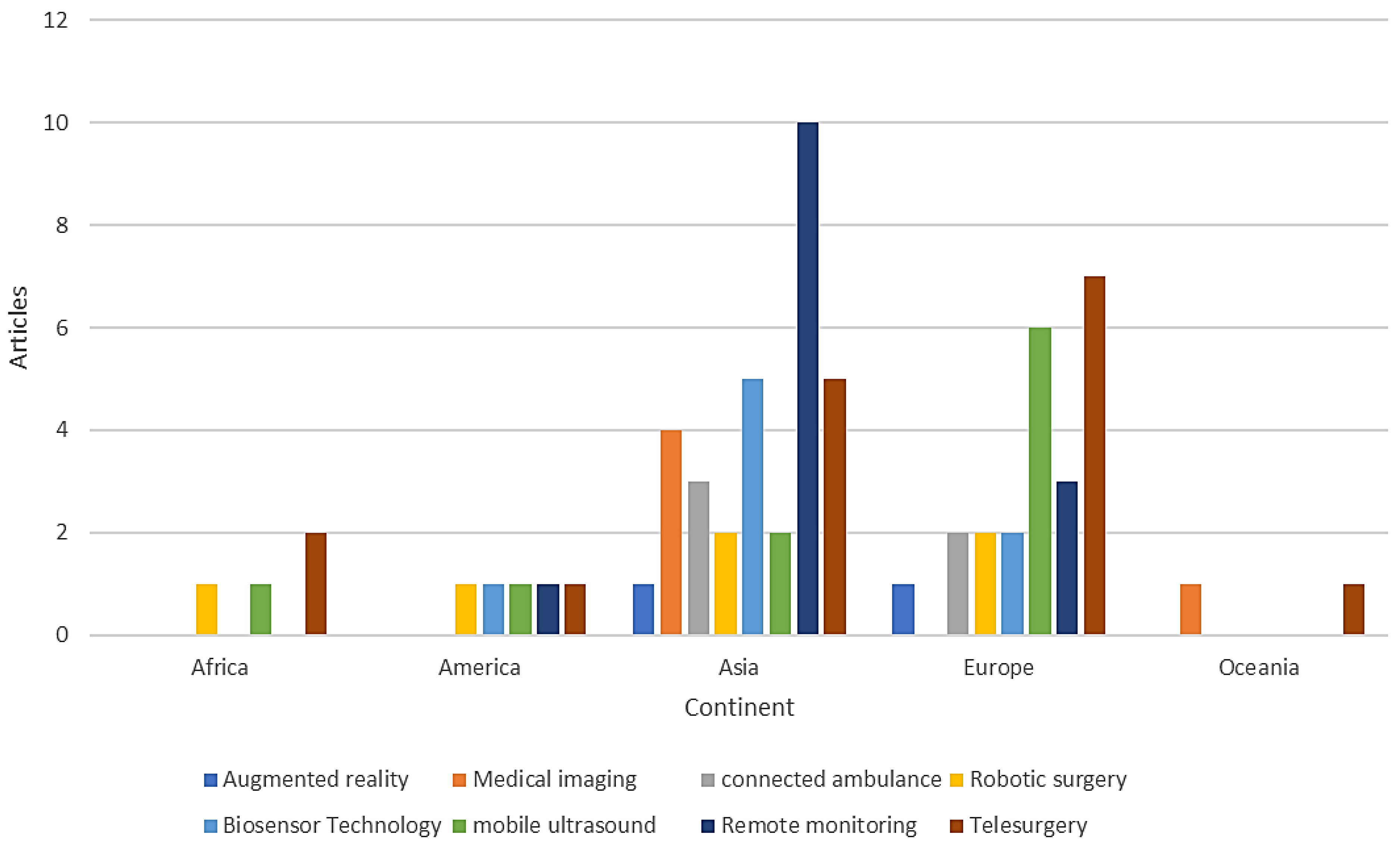

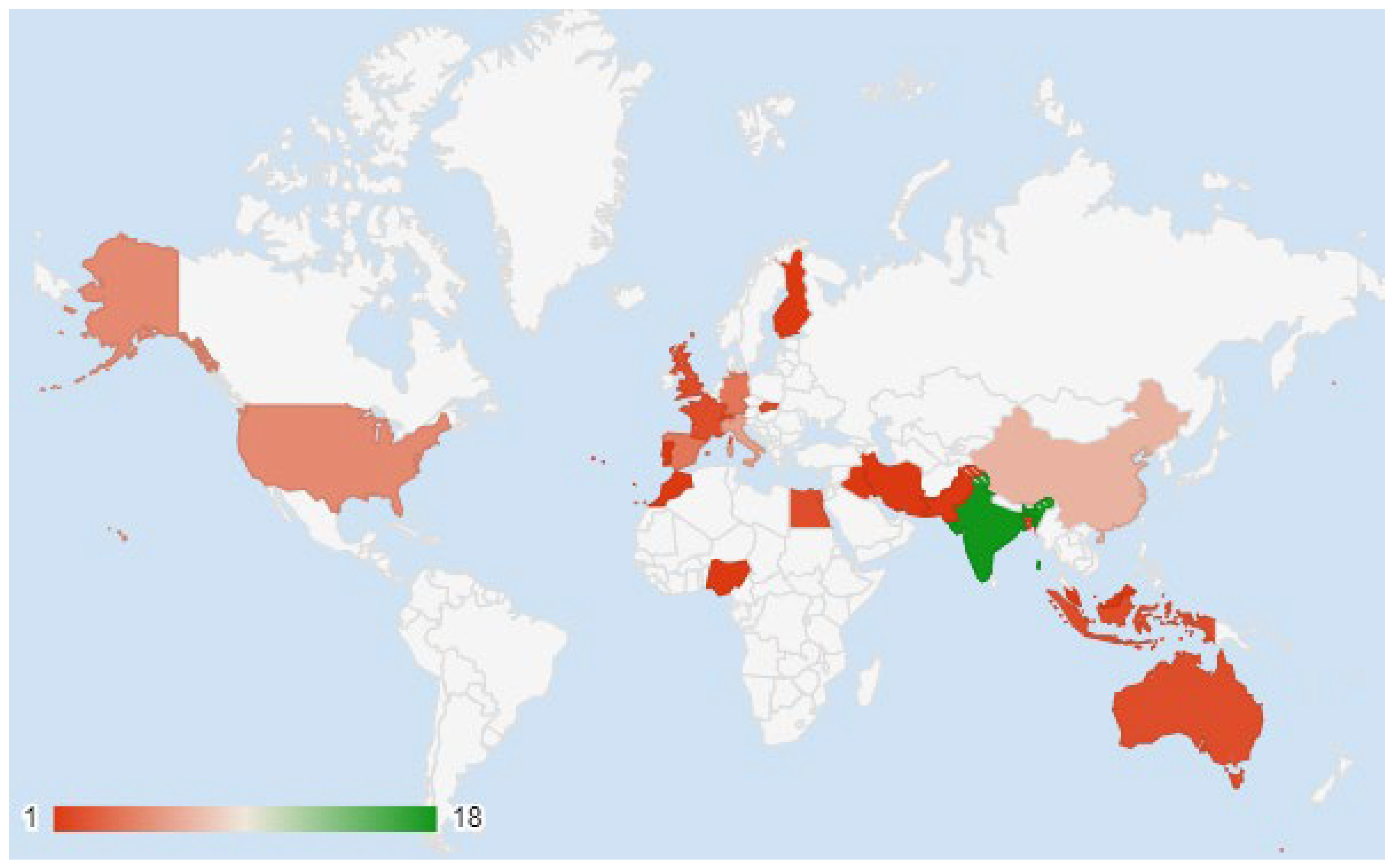
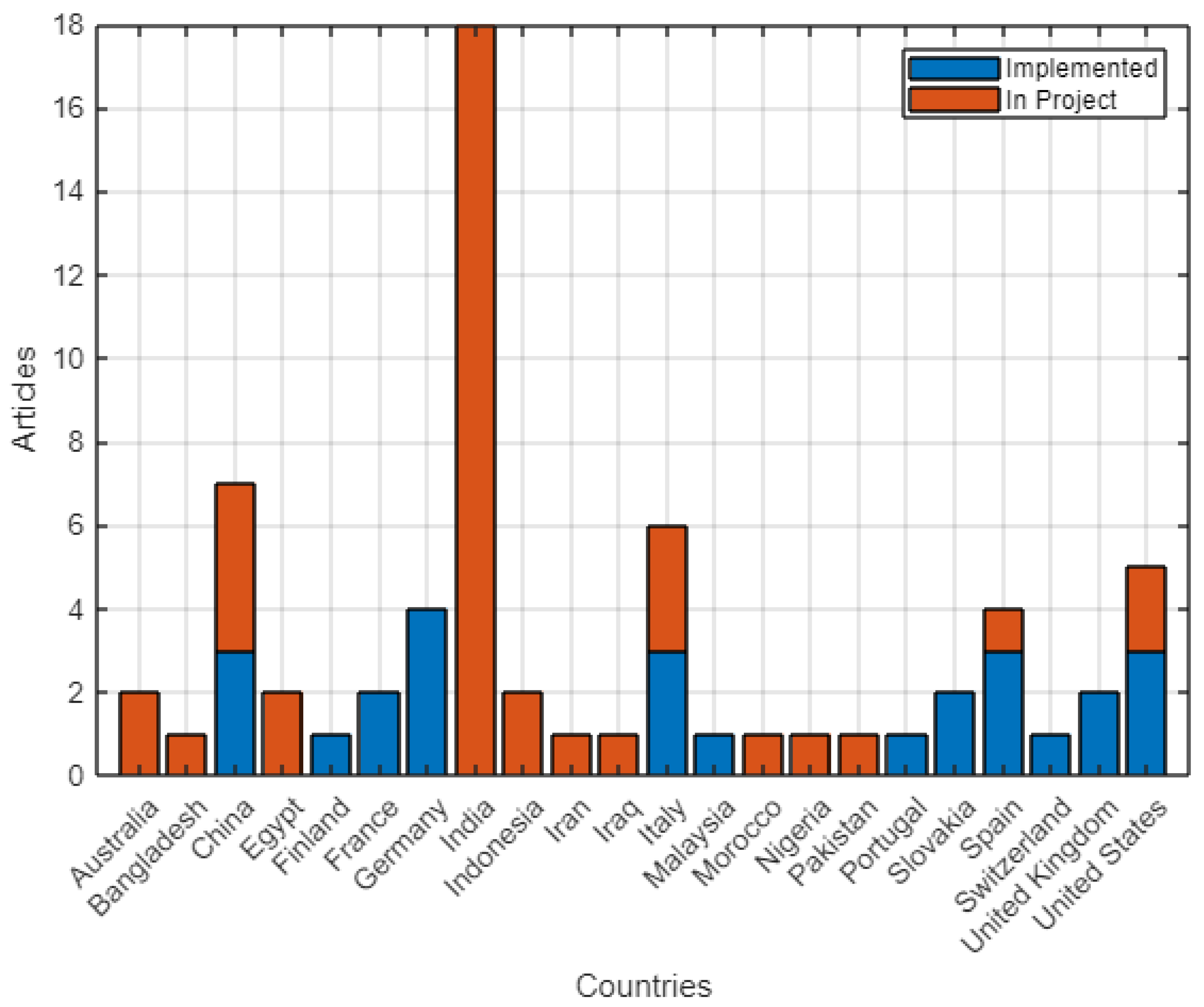
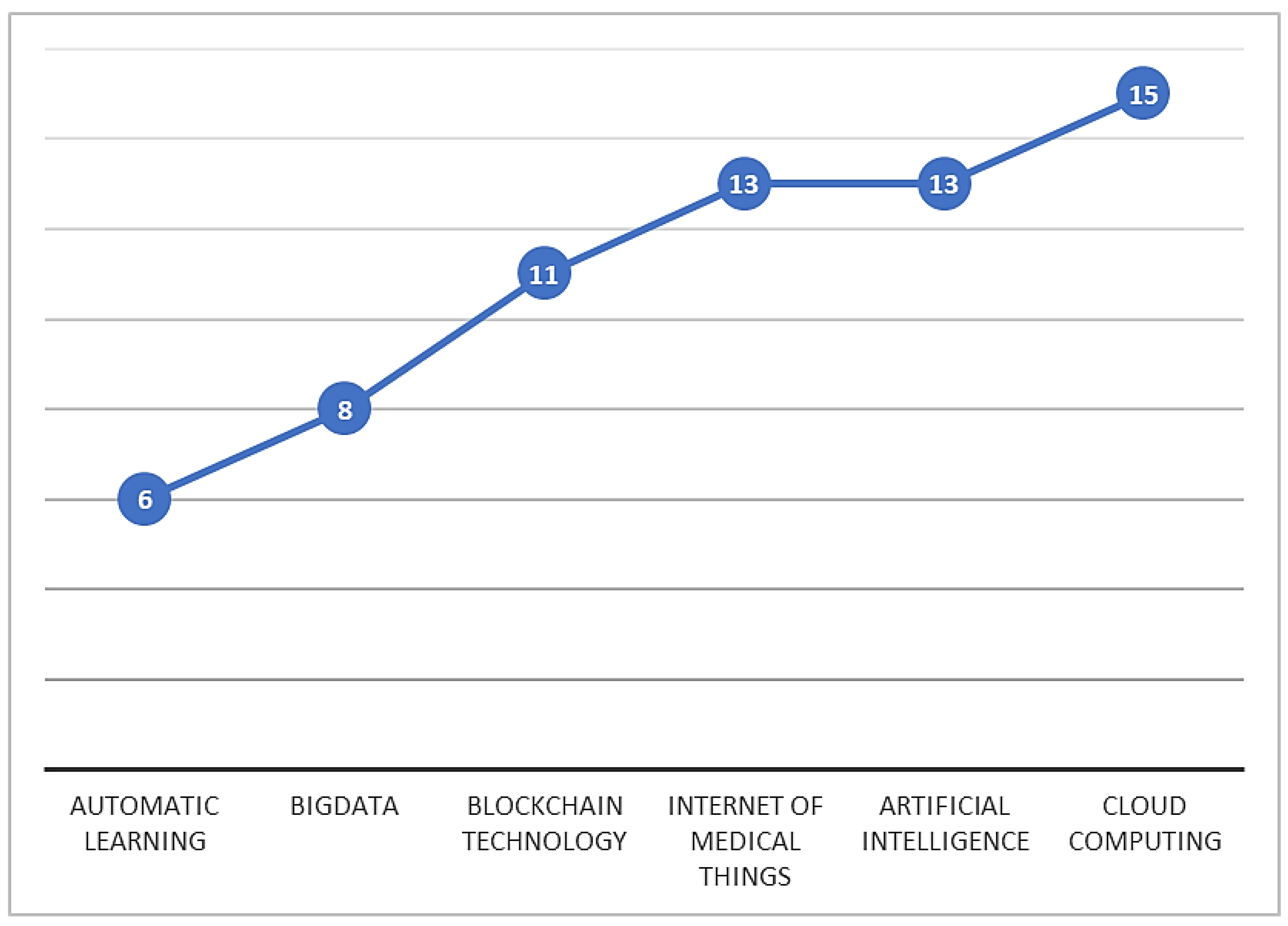
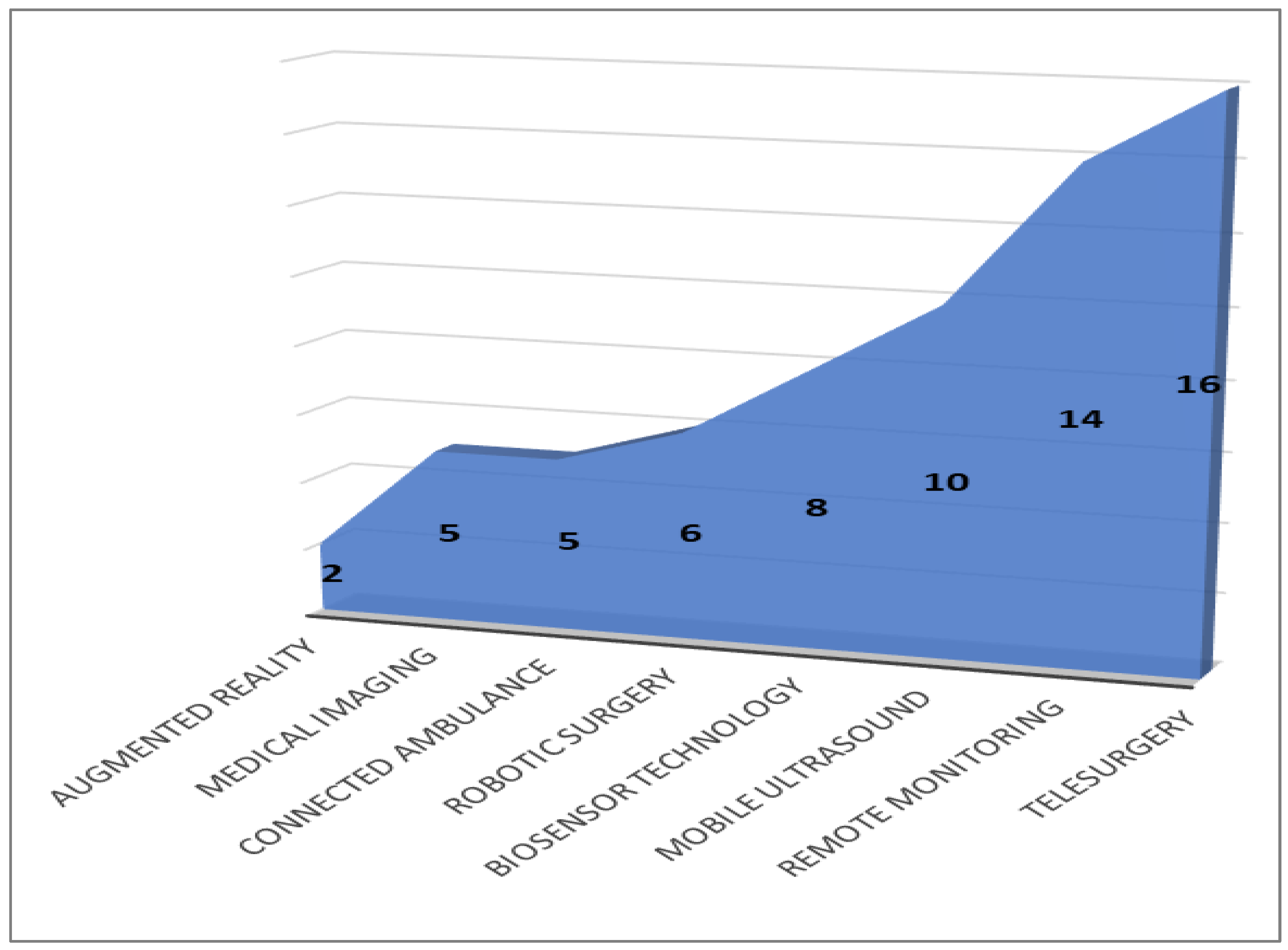
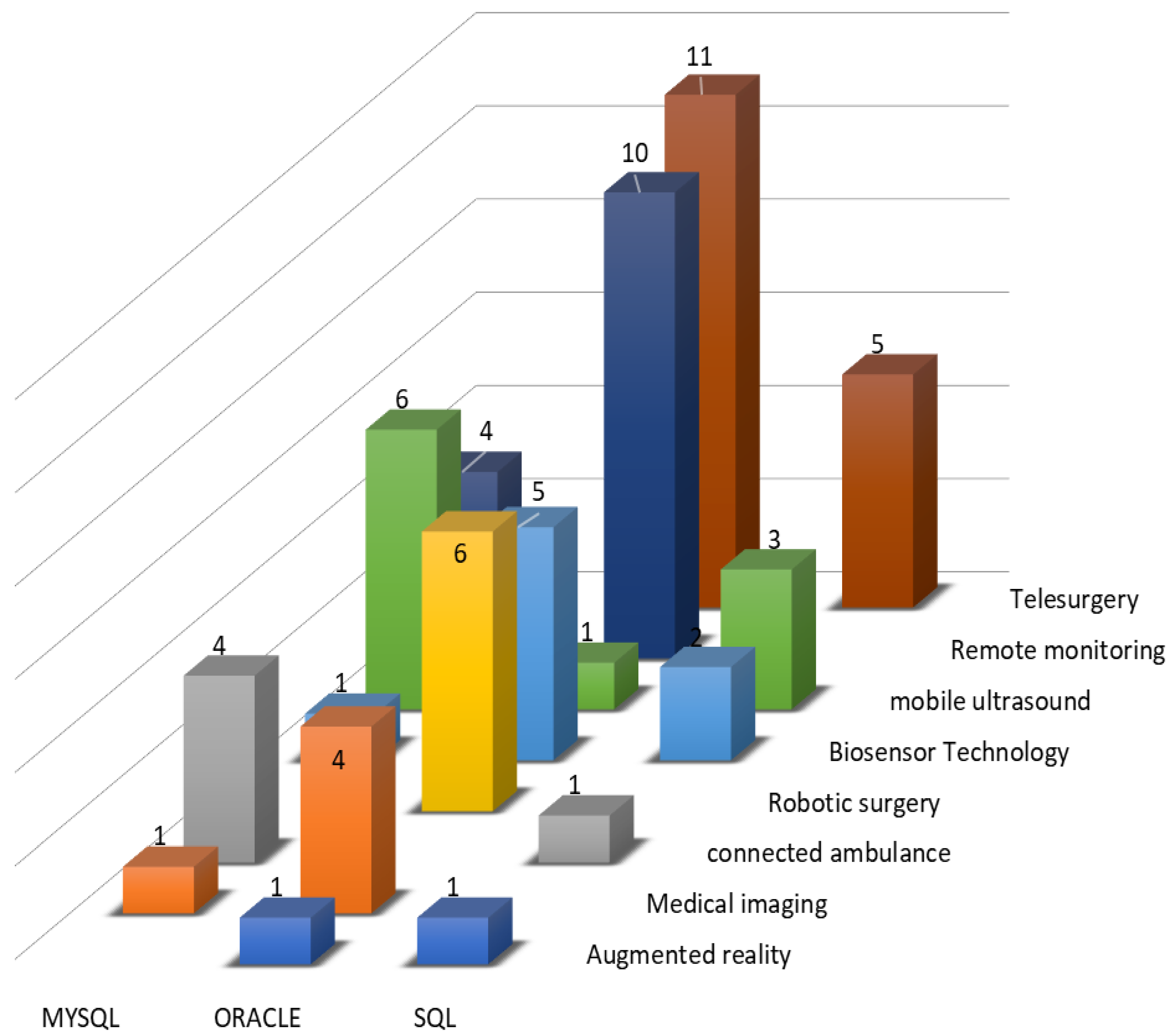
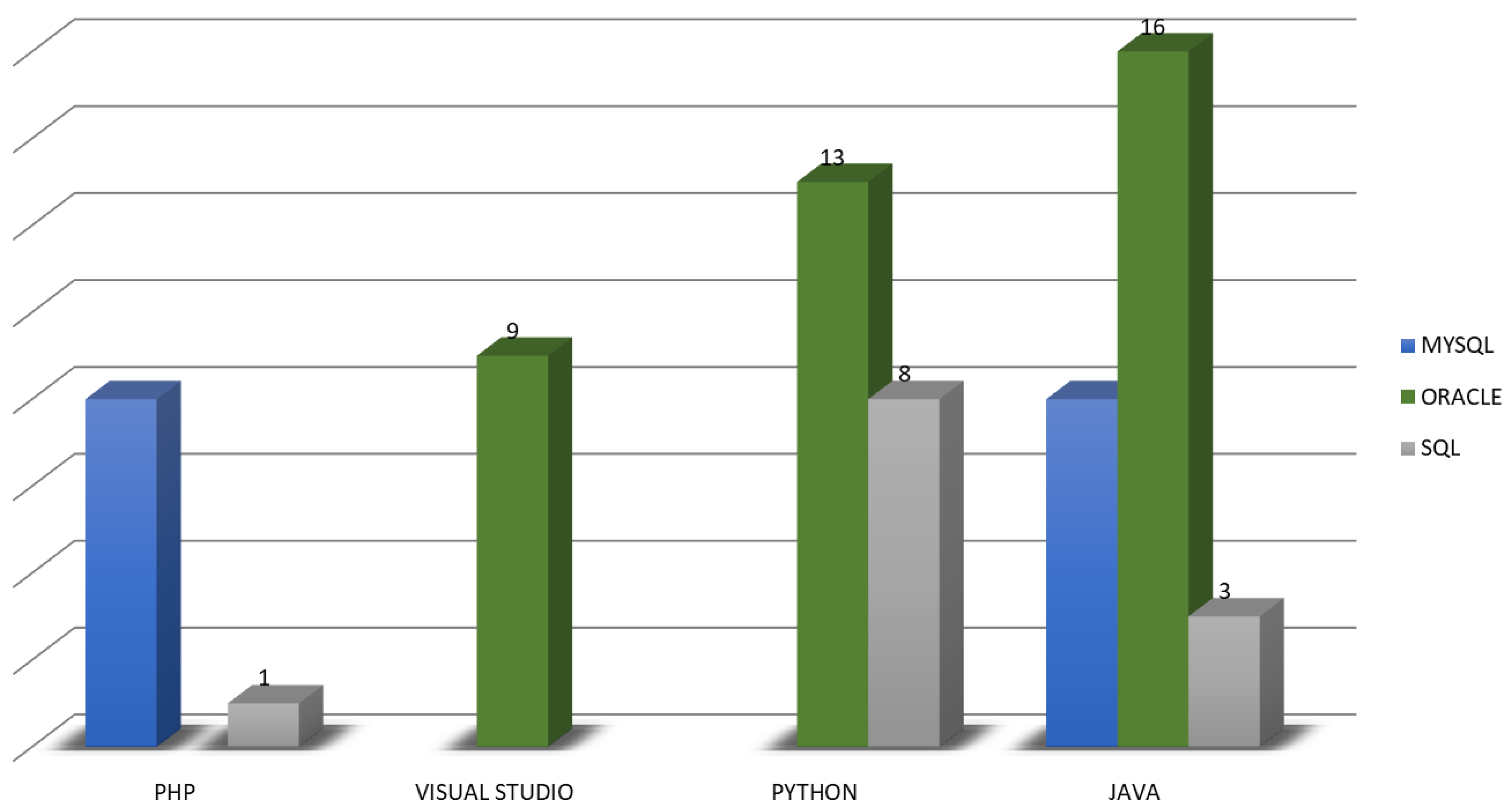
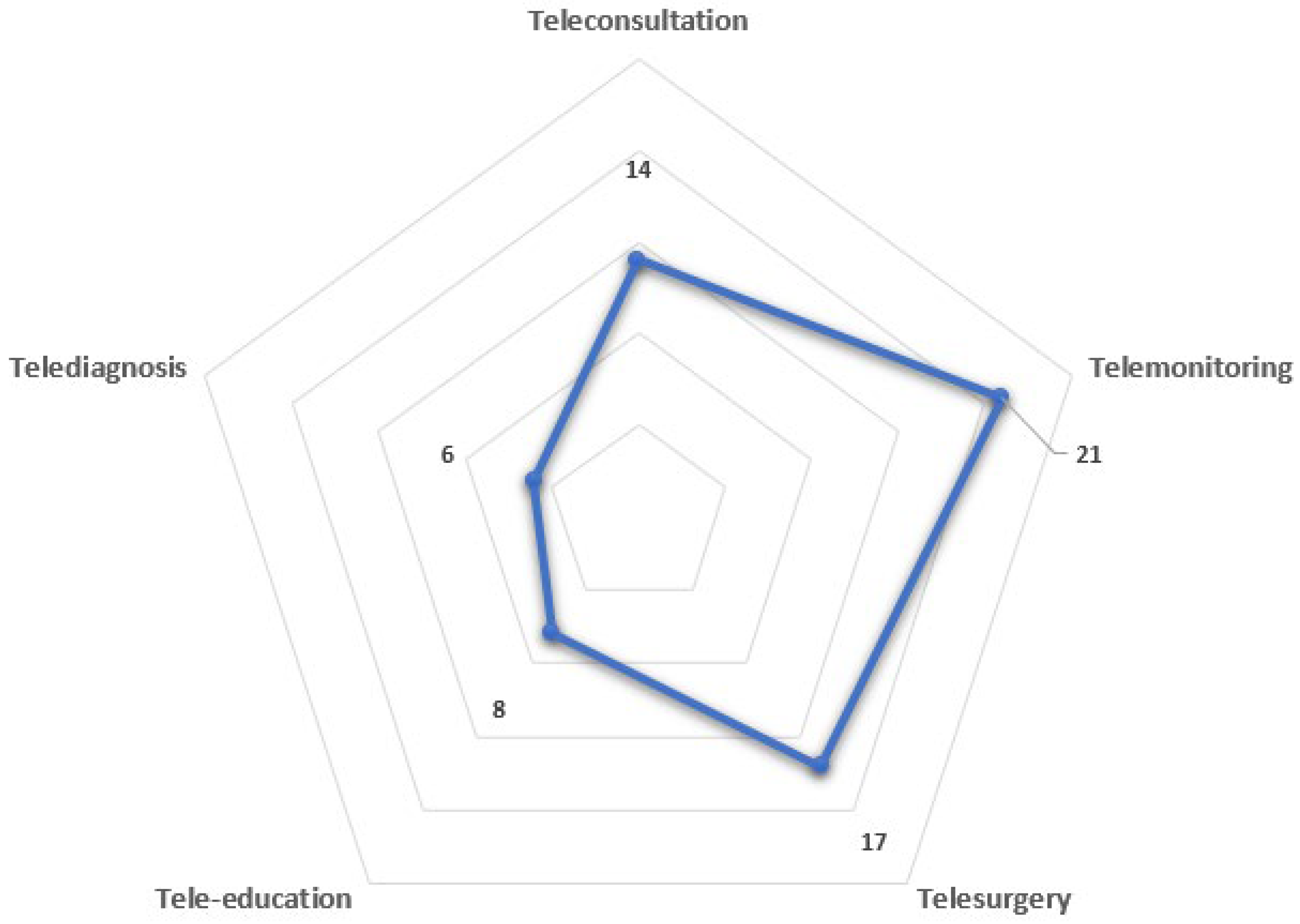
| Criteria | ||
| Inclusion | I01 | Articles related to 5G-based digital technologies used for medical care. |
| I02 | Articles that apply a methodology, a model, and/or a method in their development. | |
| I03 | Articles related to the impact of 5G networks on healthcare. | |
| I04 | Articles published since 2018. | |
| Exclusion | E01 | Unrelated articles on 5G-based digital technologies used for health care. |
| E02 | Articles that do not apply a methodology, model, and/or method in their development. | |
| E03 | Articles that do not partially answer the research questions. | |
| E04 | Articles published prior to 2018. | |
| Continente | Population Million | Implemented | In Project | Total | Density (Implemented/Population) × 1000 |
|---|---|---|---|---|---|
| Asia | 4600 | 4 | 28 | 32 | 0.87 |
| Oceania | 43 | 0 | 2 | 2 | 0.00 |
| America | 1000 | 3 | 2 | 5 | 3.00 |
| Africa | 1300 | 0 | 4 | 4 | 0.00 |
| Europe | 750 | 19 | 4 | 23 | 25.33 |
| Total | 26 | 40 | 66 | ||
| Categories | Quantity | Articles |
|---|---|---|
| Cloud computing | 15 | [37,38,38,39,40,41,42,43,44,45,46,47,48,49,50] |
| Artificial intelligence | 13 | [51,52,53,54,55,56,57,58,59,60,61,62,63] |
| Internet of medical things | 13 | [46,59,64,64,65,65,66,67,68,69,70,71,72] |
| Blockchain technology | 11 | [73,73,74,75,76,77,78,79,80,81,82] |
| Big data | 8 | [83,84,85,86,87,88,89,90] |
| Automatic learning | 6 | [91,92,93,94,95,96] |
| Categories | Quantity | Articles |
|---|---|---|
| Telesurgery | 16 | [47,55,56,57,58,60,61,69,73,73,74,76,77,81,82,92] |
| Remote monitoring | 14 | [37,44,45,50,63,64,65,68,78,84,87,88,90,95] |
| Mobile ultrasound | 10 | [38,38,42,49,59,72,83,86,89,93] |
| Biosensor Technology | 8 | [39,40,46,67,70,85,94,96] |
| Robotic surgery | 6 | [43,52,54,59,62,75] |
| Connected ambulance | 5 | [46,48,64,65,79] |
| Medical imaging | 5 | [41,51,66,71,80] |
| Augmented reality | 2 | [53,91] |
| Categorie | Article | Descriptión |
|---|---|---|
| Telesurgery | [47] | Proposed system for remote patient monitoring (RPM) based on 5G network, allowing to provide a wide range of medical services. |
| Mobile ultrasound | [72] | Clinical evaluation of telemedical transmission and applicability of ultrasound probes between ambulance and remote hospital sites implementing core slicing over 5G network. |
| Connected ambulance | [46] | Use of 5G technology, mobile edge computing, and heterogeneous network management for healthcare network service flows applied to the connected ambulance. |
| Robotic surgery | [54] | A multisensor fusion method based on interpretable neural networks (MFIN) for BSN in medical scenarios of doctor-robot-human interaction. |
| Remote monitoring | [47] | Proposal for a 5G remote patient monitoring (RPM) system to deliver a wide range of healthcare services and identify the potential impact of 5G in Spain on the delivery of eHealth services. |
| Biosensor Technology | [97] | Wearable biosensors for wearable devices and their use in healthcare monitoring. |
| Categories | Quantity | Articles |
|---|---|---|
| Telemonitoring | 21 | [37,39,40,44,45,46,49,50,53,63,70,73,73,76,77,78,81,84,87,88,95] |
| Teleconsultation | 14 | [38,38,42,48,66,72,79,85,86,89,91,93,94,96] |
| Telesurgery | 17 | [43,47,52,54,55,56,57,58,59,60,61,62,69,74,75,82,92] |
| Tele-education | 8 | [46,59,64,64,65,68,83,90] |
| Telediagnosis | 6 | [41,51,65,67,71,80] |
Disclaimer/Publisher’s Note: The statements, opinions and data contained in all publications are solely those of the individual author(s) and contributor(s) and not of MDPI and/or the editor(s). MDPI and/or the editor(s) disclaim responsibility for any injury to people or property resulting from any ideas, methods, instructions or products referred to in the content. |
© 2023 by the authors. Licensee MDPI, Basel, Switzerland. This article is an open access article distributed under the terms and conditions of the Creative Commons Attribution (CC BY) license (https://creativecommons.org/licenses/by/4.0/).
Share and Cite
Cabanillas-Carbonell, M.; Pérez-Martínez, J.; A. Yáñez, J. 5G Technology in the Digital Transformation of Healthcare, a Systematic Review. Sustainability 2023, 15, 3178. https://doi.org/10.3390/su15043178
Cabanillas-Carbonell M, Pérez-Martínez J, A. Yáñez J. 5G Technology in the Digital Transformation of Healthcare, a Systematic Review. Sustainability. 2023; 15(4):3178. https://doi.org/10.3390/su15043178
Chicago/Turabian StyleCabanillas-Carbonell, Michael, Jorge Pérez-Martínez, and Jaime A. Yáñez. 2023. "5G Technology in the Digital Transformation of Healthcare, a Systematic Review" Sustainability 15, no. 4: 3178. https://doi.org/10.3390/su15043178
APA StyleCabanillas-Carbonell, M., Pérez-Martínez, J., & A. Yáñez, J. (2023). 5G Technology in the Digital Transformation of Healthcare, a Systematic Review. Sustainability, 15(4), 3178. https://doi.org/10.3390/su15043178








